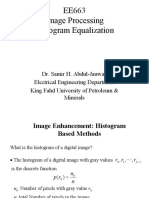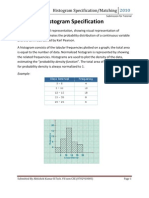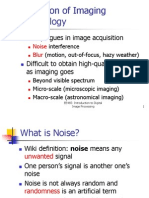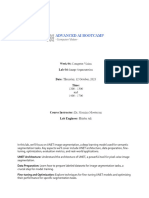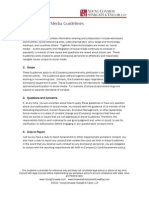Lab 1 - Basics of Image Processing
Uploaded by
susareshLab 1 - Basics of Image Processing
Uploaded by
susareshUniversity of Louisville Electrical and Computer Engineering
Dr. Aly A. Farag Spring 2008
ECE 619: Computer Vision Lab 1: Basics of Image Processing (Using Matlab image processing toolbox Issued Thursday 1/10 Due 1/24) Task 1: Execute the steps outlined below to get familiar with basics of image processing using Matlab. Task 2: Use your own image(s); submit a short report on the following tasks: 1) Image enhancement by histogram equalization; 2) Edge enhancement by the Cross window operator; 3) Edge detection by Canny operator; 4) Removal of white Gaussian noise using Gaussian and Median filters for different SNR. Help on this assignment was provided by Shireen Elhabian.
Main Topics
Example 1 Some Basic Concepts .......................................................................................... 1 Introduction............................................................................................................................. 1 Step 1: Read and Display an Image ........................................................................................ 2 Step 2: Check How the Image Appears in the Workspace ..................................................... 2 Step 3: Improve Image Contrast ............................................................................................. 3 Step 4: Write the Image to a Disk File.................................................................................... 4 Example 2 Advanced Topics ................................................................................................. 4 Introduction............................................................................................................................. 4 Step 1: Read and Display an Image ........................................................................................ 4 Step 2: Estimate the Value of Background Pixels .................................................................. 5 Step 3: View the Background Approximation as a Surface ................................................... 5 Step 4: Create an Image with a Uniform Background............................................................ 6 Step 5: Adjust the Contrast in the Processed Image ............................................................... 6 Step 6: Create a Binary Version of the Image ........................................................................ 7 Step 7: Determine the Number of Objects in the Image......................................................... 8 Step 8: Examine the Label Matrix .......................................................................................... 8 Step 9: Display the Label Matrix as a Pseudocolor Indexed Image ....................................... 9 Step 10: Measure Object Properties in the Image................................................................... 9 Step 11: Compute Statistical Properties of Objects in the Image ......................................... 10
Example 1 Some Basic Concepts
Introduction This example introduces some basic image processing concepts. The example starts by reading an image into the MATLAB workspace. The example then performs some contrast adjustment on the image. Finally, the example writes the adjusted image to a file.
Page 1 of 10
University of Louisville Electrical and Computer Engineering
Step 1: Read and Display an Image
Dr. Aly A. Farag Spring 2008
First, clear the MATLAB workspace of any variables and close open figure windows.
close all
To read an image, use the imread command. The example reads one of the sample images included with Image Processing Toolbox, pout.tif, and stores it in an array named I.
I = imread('pout.tif');
Now display the image. The toolbox includes two image display functions: imshow and imtool. imshow is the toolbox's fundamental image display function. imtool starts the Image Tool which presents an integrated environment for displaying images and performing some common image processing tasks. The Image Tool provides all the image display capabilities of imshow but also provides access to several other tools for navigating and exploring images, such as scroll bars, the Pixel Region tool, Image Information tool, and the Contrast Adjustment tool. This example uses imshow.
imshow(I)
Grayscale Image pout.tif
Step 2: Check How the Image Appears in the Workspace To see how the imread function stores the image data in the workspace, check the Workspace browser in the MATLAB desktop. The Workspace browser displays information about all the variables you create during a MATLAB session. The imread function returned the image data in the variable I, which is a 291-by-240 element array of uint8 data. MATLAB can store images as uint8, uint16, or double arrays. You can also get information about variables in the workspace by calling the whos command.
whos
MATLAB responds with
Name
Size
Bytes
Class
Attributes
291x240
69840
uint8
Page 2 of 10
University of Louisville Electrical and Computer Engineering
Step 3: Improve Image Contrast
Dr. Aly A. Farag Spring 2008
pout.tif is a somewhat low contrast image. To see the distribution of intensities in pout.tif, you can create a histogram by calling the imhist function. (Precede the call to imhist with the figure command so that the histogram does not overwrite the display of the image I in the current figure window.) figure, imhist(I)
Notice how the intensity range is rather narrow. It does not cover the potential range of [0, 255], and is missing the high and low values that would result in good contrast. The toolbox provides several ways to improve the contrast in an image. One way is to call the histeq function to spread the intensity values over the full range of the image, a process called histogram equalization.
I2 = histeq(I);
Display the new equalized image, I2, in a new figure window.
figure, imshow(I2)
Equalized Version of pout.tif
Page 3 of 10
University of Louisville Electrical and Computer Engineering
Dr. Aly A. Farag Spring 2008
Call imhist again to create a histogram of the equalized image I2. If you compare the two histograms, the histogram of I2 is more spread out than the histogram of I1.
figure, imhist(I2)
The toolbox includes several other functions that perform contrast adjustment, including the imadjust and adapthisteq functions. In addition, the toolbox includes an interactive tool, called the Adjust Contrast tool, that you can use to adjust the contrast and brightness of an image displayed in the Image Tool. To use this tool, call the imcontrast function or access the tool from the Image Tool. Step 4: Write the Image to a Disk File To write the newly adjusted image I2 to a disk file, use the imwrite function. If you include the filename extension '.png', the imwrite function writes the image to a file in Portable Network Graphics (PNG) format, but you can specify other formats.
imwrite (I2, 'pout2.png');
Example 2 Advanced Topics
Introduction This example introduces some advanced image processing concepts, such as calculating statistics about objects in the image. The example performs some preprocessing of the image, such as evening out the background illumination and converting the image into a binary image, that help achieve better results in the statistics calculation. Step 1: Read and Display an Image First, clear the MATLAB workspace of any variables, close open figure windows, and close all open Image Tools.
close all
Read and display the grayscale image rice.png.
I = imread('rice.png'); imshow(I)
Page 4 of 10
University of Louisville Electrical and Computer Engineering
Grayscale Image rice.png
Dr. Aly A. Farag Spring 2008
Step 2: Estimate the Value of Background Pixels In the sample image, the background illumination is brighter in the center of the image than at the bottom. In this step, the example uses a morphological opening operation to estimate the background illumination. Morphological opening is an erosion followed by a dilation, using the same structuring element for both operations. The opening operation has the effect of removing objects that cannot completely contain the structuring element. The example calls the imopen function to perform the morphological opening operation and then calls the imshow function to view the results. Note how the example calls the strel function to create a disk-shaped structuring element with a radius of 15. To remove the rice grains from the image, the structuring element must be sized so that it cannot fit entirely inside a single grain of rice.
background = imopen(I,strel('disk',15)); figure, imshow(background)
Step 3: View the Background Approximation as a Surface Use the surf command to create a surface display of the background approximation background. The surf command creates colored parametric surfaces that enable you to view mathematical functions over a rectangular region. The surf function requires data of class double, however, so you first need to convert background using the double command.
figure, surf(double(background(1:8:end,1:8:end))),zlim([0 255]); set(gca,'ydir','reverse');
The example uses MATLAB indexing syntax to view only 1 out of 8 pixels in each direction; otherwise the surface plot would be too dense. The example also sets the scale of the plot to better match the range of the uint8 data and reverses the y-axis of the display to provide a better view of the data (the pixels at the bottom of the image appear at the front of the surface plot). In the surface display, [0, 0] represents the origin, or upper left corner of the image. The highest part of the curve indicates that the highest pixel values of background (and consequently rice.png) occur near the middle rows of the image. The lowest pixel values occur at the bottom of the image and are represented in the surface plot by the lowest part of the curve.
Page 5 of 10
University of Louisville Electrical and Computer Engineering
Dr. Aly A. Farag Spring 2008
Step 4: Create an Image with a Uniform Background To create a more uniform background, subtract the background image, background, from the original image, I, and then view the image.
I2 = imsubtract(I,background); figure, imshow(I2)
Image with Uniform Background
Step 5: Adjust the Contrast in the Processed Image After subtraction, the image has a uniform background but is now a bit too dark. Use imadjust to adjust the contrast of the image. imadjust increases the contrast of the image by saturating 1% of the data at both low and high intensities of I2 and by stretching the intensity values to fill the uint8 dynamic range. The following example adjusts the contrast in the image created in the previous step and displays it.
I3 = imadjust(I2);
Page 6 of 10
University of Louisville Electrical and Computer Engineering
figure, imshow(I3);
Image After Intensity Adjustment
Dr. Aly A. Farag Spring 2008
Step 6: Create a Binary Version of the Image Create a binary version of the image so that you can use toolbox functions to count the number of rice grains. Use the im2bw function to convert the grayscale image into a binary image by using thresholding. The function graythresh automatically computes an appropriate threshold to use to convert the grayscale image to binary.
level = graythresh(I3); bw = im2bw(I3,level); figure, imshow(bw)
Binary Version of the Image
The binary image bw returned by im2bw is of class logical.
Page 7 of 10
University of Louisville Electrical and Computer Engineering
Step 7: Determine the Number of Objects in the Image
Dr. Aly A. Farag Spring 2008
After converting the image to a binary image, you can use the bwlabel function to determine the number of grains of rice in the image. The bwlabel function labels all the components in the binary image bw and returns the number of components it finds in the image in the output value, numObjects.
[labeled,numObjects] = bwlabel(bw,4);
The accuracy of the results depends on a number of factors, including
The size of the objects Whether or not any objects are touching (in which case they might be labeled as one object) The accuracy of the approximated background The connectivity selected. The parameter 4, passed to the bwlabel function, means that pixels must touch along an edge to be considered connected.
Step 8: Examine the Label Matrix To better understand the label matrix returned by the bwlabel function, this step explores the pixel values in the image. There are several ways to get a close-up view of pixel values. For example, you can use imcrop to select a small portion of the image. Another way is to use the Pixel Region tool to examine pixel values. The following example displays the label matrix, using imshow, and then starts a Pixel Region tool associated with the displayed image.
figure, imshow(labeled); impixelregion
By default, the Pixel Region tool automatically associates itself with the image in the current figure. The Pixel Region tool draws a rectangle, called the pixel region rectangle, in the center of the visible part of the image. This rectangle defines which pixels are displayed in the Pixel Region tool. As you move the rectangle, the Pixel Region tool updates its display of pixel values. The following figure shows the Pixel Region rectangle positioned over the edges of two rice grains. Note how all the pixels in the rice grains have the values assigned by the bwlabel function and the background pixels have the value 0 (zero). Examining the Label Matrix with the Pixel Region Tool
Page 8 of 10
University of Louisville Electrical and Computer Engineering
Step 9: Display the Label Matrix as a Pseudocolor Indexed Image
Dr. Aly A. Farag Spring 2008
A good way to view a label matrix is to display it as a pseudocolor indexed image. In the pseudocolor image, the number that identifies each object in the label matrix maps to a different color in the associated colormap matrix. The colors in the image make objects easier to distinguish. To view a label matrix in this way, use the label2rgb function. Using this function, you can specify the colormap, the background color, and how objects in the label matrix map to colors in the colormap.
pseudo_color = label2rgb(labeled, @spring, 'c', 'shuffle'); figure, imshow(pseudo_color);
Label Matrix Displayed as Pseudocolor Image
Step 10: Measure Object Properties in the Image The regionprops command measures object or region properties in an image and returns them in a structure array. When applied to an image with labeled components, it creates one structure element for each component. The following example uses regionprops to create a structure array containing some basic properties for labeled. When you set the properties parameter to 'basic', the regionprops function returns three commonly used measurements, area, centroid, and bounding box, for all the objects in the label matrix.. The bounding box represents the smallest rectangle that can contain a component, or in this case, a grain of rice.
graindata = regionprops(labeled,'basic')
MATLAB responds with
graindata =
101x1 struct array with fields: Area Centroid BoundingBox
To find the area of the 51st labeled component (grain of rice), access the Area field in the 51st element in the graindata structure array. Note that structure field names are case sensitive.
area51 = graindata(51).Area
Page 9 of 10
University of Louisville Electrical and Computer Engineering
returns the following results
Dr. Aly A. Farag Spring 2008
area51 =
140
Step 11: Compute Statistical Properties of Objects in the Image Now use MATLAB functions to calculate some statistical properties of the thresholded objects. First use max to find the size of the largest grain. (In this example, the largest grain is actually two grains of rice that are touching.)
maxArea = max([graindata.Area])
returns
maxArea =
404
Use the find command to return the component label of the grain of rice with this area.
biggestGrain = find([graindata.Area]==maxArea)
returns
biggestGrain =
59
Find the mean of all the rice grain sizes.
meanArea = mean([graindata.Area])
returns
meanArea =
175.0396
Make a histogram containing 20 bins that show the distribution of rice grain sizes. The histogram shows that the most common sizes for rice grains in this image are in the range of 150 to 250 pixels.
hist([graindata.Area],20)
Page 10 of 10
You might also like
- Beers Law Lab Guidedinquiry Studenthandout Docx-Alexaguilar60% (5)Beers Law Lab Guidedinquiry Studenthandout Docx-Alexaguilar4 pages
- Anti-Aliasing Filter Design Using Matlab, An Image Processing Project86% (7)Anti-Aliasing Filter Design Using Matlab, An Image Processing Project24 pages
- Exhaust and Muffler Design of A Formula SAE Car67% (3)Exhaust and Muffler Design of A Formula SAE Car14 pages
- asset-v1-UQx BIOIMG101x 1T2016 Type@asset block@BIOIMG101x - SyllabusNo ratings yetasset-v1-UQx BIOIMG101x 1T2016 Type@asset block@BIOIMG101x - Syllabus8 pages
- EE663 Image Processing Histogram EqualizationNo ratings yetEE663 Image Processing Histogram Equalization38 pages
- NANENG 335 - Lecture 00 Course Introduction - Spring 2020No ratings yetNANENG 335 - Lecture 00 Course Introduction - Spring 202063 pages
- Chapter_1_Introduction_to_computer_vision_and_image_processing_forNo ratings yetChapter_1_Introduction_to_computer_vision_and_image_processing_for81 pages
- 05 Multi-Scale Derivatives - ImplementationsNo ratings yet05 Multi-Scale Derivatives - Implementations19 pages
- Introduction To Convolutional Neural NetworksNo ratings yetIntroduction To Convolutional Neural Networks41 pages
- Digital Image Processing Using Matlab: Basic Transformations, Filters, Operators100% (2)Digital Image Processing Using Matlab: Basic Transformations, Filters, Operators20 pages
- Ma5160 Applied Probability and Statistics 1 PDF50% (2)Ma5160 Applied Probability and Statistics 1 PDF4 pages
- Modeling Data and Curve Fitting - Non-Linear Least-Squares Minimization and Curve-Fitting For PythonNo ratings yetModeling Data and Curve Fitting - Non-Linear Least-Squares Minimization and Curve-Fitting For Python25 pages
- Figure Style and Scale: Darkgrid Whitegrid Dark White Ticks DarkgridNo ratings yetFigure Style and Scale: Darkgrid Whitegrid Dark White Ticks Darkgrid15 pages
- Computer Vision Notes: Confirmed Midterm Exam Guide (Kisi-Kisi UTS)No ratings yetComputer Vision Notes: Confirmed Midterm Exam Guide (Kisi-Kisi UTS)24 pages
- MATLAB: Image Processing Operations Read and Display An ImageNo ratings yetMATLAB: Image Processing Operations Read and Display An Image13 pages
- CENG 3264: Engin Des and Project MGMT - Lab 3 Matlab Tutorial II - Image ProcessingNo ratings yetCENG 3264: Engin Des and Project MGMT - Lab 3 Matlab Tutorial II - Image Processing5 pages
- Air Traffic Control (ATC) Simulator: TitleNo ratings yetAir Traffic Control (ATC) Simulator: Title24 pages
- Introduction To MU-MIMO: by Pradip Paudyal Ppaudyal@nta - Gov.npNo ratings yetIntroduction To MU-MIMO: by Pradip Paudyal Ppaudyal@nta - Gov.np19 pages
- Sample - Salmon Market (2022 - 2027) - Mordor IntelligenceNo ratings yetSample - Salmon Market (2022 - 2027) - Mordor Intelligence23 pages
- VMware KB - Sample Configuration of Virtual Switch VLAN Tagging (VST ModeNo ratings yetVMware KB - Sample Configuration of Virtual Switch VLAN Tagging (VST Mode4 pages
- Overlapnet: Loop Closing For Lidar-Based SlamNo ratings yetOverlapnet: Loop Closing For Lidar-Based Slam10 pages
- Invisible Cities: Moriana Progression and Final OutcomeNo ratings yetInvisible Cities: Moriana Progression and Final Outcome14 pages
- Typhoon Yolanda: An Analysis On The Impact of Natural Disasters and Effectiveness of Disaster ManagementNo ratings yetTyphoon Yolanda: An Analysis On The Impact of Natural Disasters and Effectiveness of Disaster Management7 pages
- Brake Master Cylinder - Expansion Tank BMW E60 Sedan 47750No ratings yetBrake Master Cylinder - Expansion Tank BMW E60 Sedan 477502 pages
- Coduri de Defect: Combustibil (EKPS (Fuel Pump Control) - Diagnose)No ratings yetCoduri de Defect: Combustibil (EKPS (Fuel Pump Control) - Diagnose)4 pages
- XBee ZB Command Reference Tables - in Alphabetical FormNo ratings yetXBee ZB Command Reference Tables - in Alphabetical Form8 pages
- 30-Longest Increasing Subsequence-22-03-2024No ratings yet30-Longest Increasing Subsequence-22-03-202423 pages
- Sample Social Media Policy For EmployersNo ratings yetSample Social Media Policy For Employers3 pages
- Linux Firewall: For The Office and HomeNo ratings yetLinux Firewall: For The Office and Home53 pages
- Download full Animal Skeletons and Anatomy An Image Archive for Artists and Designers Kale James ebook all chapters100% (1)Download full Animal Skeletons and Anatomy An Image Archive for Artists and Designers Kale James ebook all chapters34 pages
- Auger Torque ME Price Guide 2020 Final 040620No ratings yetAuger Torque ME Price Guide 2020 Final 0406203 pages
- Beers Law Lab Guidedinquiry Studenthandout Docx-AlexaguilarBeers Law Lab Guidedinquiry Studenthandout Docx-Alexaguilar
- Anti-Aliasing Filter Design Using Matlab, An Image Processing ProjectAnti-Aliasing Filter Design Using Matlab, An Image Processing Project
- asset-v1-UQx BIOIMG101x 1T2016 Type@asset block@BIOIMG101x - Syllabusasset-v1-UQx BIOIMG101x 1T2016 Type@asset block@BIOIMG101x - Syllabus
- NANENG 335 - Lecture 00 Course Introduction - Spring 2020NANENG 335 - Lecture 00 Course Introduction - Spring 2020
- Chapter_1_Introduction_to_computer_vision_and_image_processing_forChapter_1_Introduction_to_computer_vision_and_image_processing_for
- Digital Image Processing Using Matlab: Basic Transformations, Filters, OperatorsDigital Image Processing Using Matlab: Basic Transformations, Filters, Operators
- Modeling Data and Curve Fitting - Non-Linear Least-Squares Minimization and Curve-Fitting For PythonModeling Data and Curve Fitting - Non-Linear Least-Squares Minimization and Curve-Fitting For Python
- Figure Style and Scale: Darkgrid Whitegrid Dark White Ticks DarkgridFigure Style and Scale: Darkgrid Whitegrid Dark White Ticks Darkgrid
- Computer Vision Notes: Confirmed Midterm Exam Guide (Kisi-Kisi UTS)Computer Vision Notes: Confirmed Midterm Exam Guide (Kisi-Kisi UTS)
- Explorations of Mathematical Models in Biology with MATLABFrom EverandExplorations of Mathematical Models in Biology with MATLAB
- MATLAB: Image Processing Operations Read and Display An ImageMATLAB: Image Processing Operations Read and Display An Image
- CENG 3264: Engin Des and Project MGMT - Lab 3 Matlab Tutorial II - Image ProcessingCENG 3264: Engin Des and Project MGMT - Lab 3 Matlab Tutorial II - Image Processing
- Introduction To MU-MIMO: by Pradip Paudyal Ppaudyal@nta - Gov.npIntroduction To MU-MIMO: by Pradip Paudyal Ppaudyal@nta - Gov.np
- Sample - Salmon Market (2022 - 2027) - Mordor IntelligenceSample - Salmon Market (2022 - 2027) - Mordor Intelligence
- VMware KB - Sample Configuration of Virtual Switch VLAN Tagging (VST ModeVMware KB - Sample Configuration of Virtual Switch VLAN Tagging (VST Mode
- Invisible Cities: Moriana Progression and Final OutcomeInvisible Cities: Moriana Progression and Final Outcome
- Typhoon Yolanda: An Analysis On The Impact of Natural Disasters and Effectiveness of Disaster ManagementTyphoon Yolanda: An Analysis On The Impact of Natural Disasters and Effectiveness of Disaster Management
- Brake Master Cylinder - Expansion Tank BMW E60 Sedan 47750Brake Master Cylinder - Expansion Tank BMW E60 Sedan 47750
- Coduri de Defect: Combustibil (EKPS (Fuel Pump Control) - Diagnose)Coduri de Defect: Combustibil (EKPS (Fuel Pump Control) - Diagnose)
- XBee ZB Command Reference Tables - in Alphabetical FormXBee ZB Command Reference Tables - in Alphabetical Form
- Download full Animal Skeletons and Anatomy An Image Archive for Artists and Designers Kale James ebook all chaptersDownload full Animal Skeletons and Anatomy An Image Archive for Artists and Designers Kale James ebook all chapters















